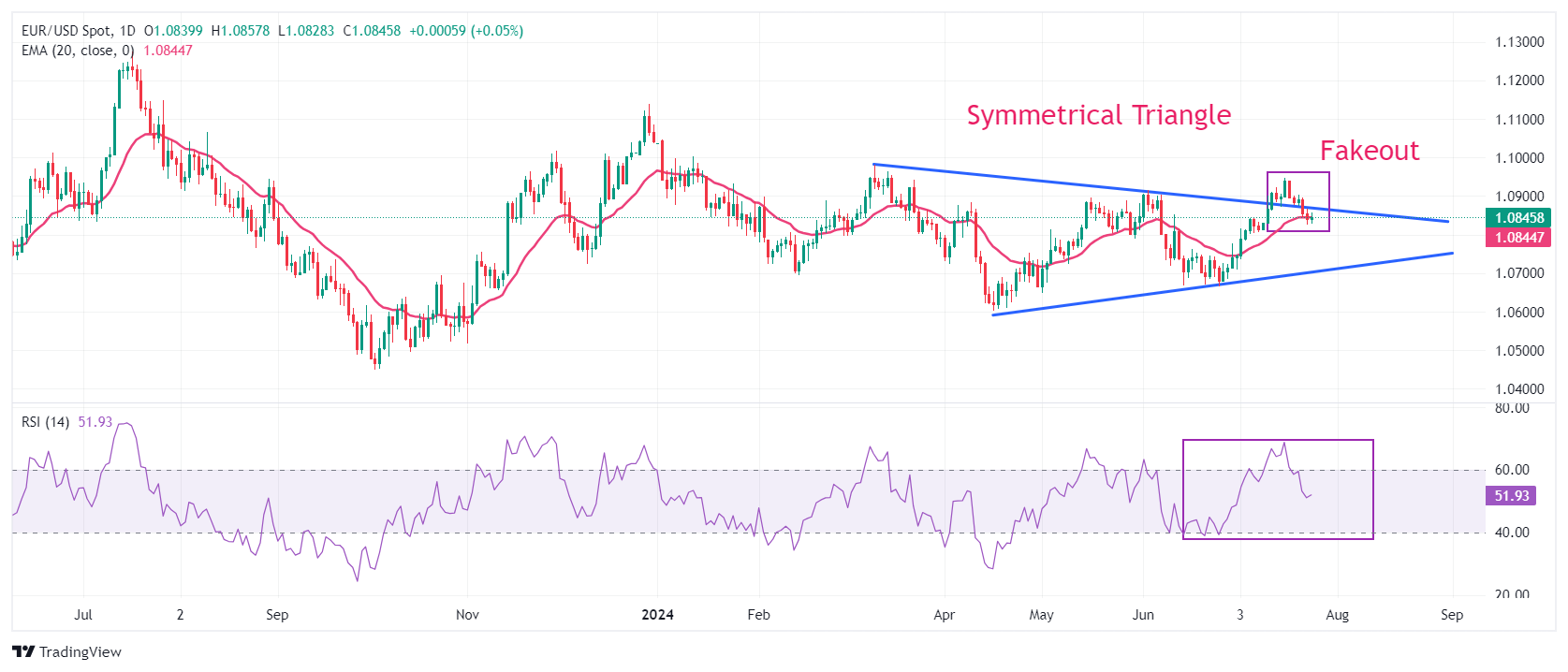EUR/USD recovers as US Dollar edges down ahead of US Q2 GDP
- EUR/USD bounces back as the US Dollar remains sluggish in the countdown to the US Q2 flash GDP.
- The Euro’s appeal remains uncertain due to the Eurozone’s dismal economic outlook.
- German government announces tax relief for households and corporations.
EUR/USD rebounds to near 1.0850 in Thursday’s European session despite the near-term outlook of the Euro remains uncertain due to firm expectations of more rate cuts by the European Central Bank (ECB) and deepening concerns over German economic prospects.
The ECB is expected to cut interest rates two more times this year as price pressures are expected to remain at their current levels for the entire year and will return to the bank’s target in 2025. Some ECB officials also see current market expectations for rate cuts as appropriate.
Meanwhile, a sharp decline in Eurozone business activity, especially in the bloc’s largest nation, Germany, has boosted expectations of more interest rate cuts this year to prompt economic growth. German flash Composite Purchasing Managers Index (PMI) unexpectedly contracted in July. Hamburg Commercial Bank (HCOB) reported on Wednesday that preliminary German Composite PMI surprisingly declined to 48.7 in July, the lowest reading in four months. The economy skirted a recession last year but contracted by 0.3%.
Poor German activity has also dampened its business sentiment index. German IFO Business Climate, an early indicator of current conditions and business expectations, surprisingly declined to 87 in July. Investors forecasted the sentiment data to have risen to 88.9 from June’s reading of 88.6. In the same period, the Expectations index unexpectedly dropped to 86.9 from the estimates of 89.0 and the former release of 88.8, downwardly revised from 89.0.
In a move to boost overall consumption, the German government promises to provide tax relief to corporations and households. The tax relief move announced by German Finance Minister Christian Lindner on Wednesday will pave way for a 30-billion-euro reduction in the tax burden in 2025 and 2026, an effort to leave the economy with more funds for spending and investment.
Daily digest market movers: EUR/USD recovers while the Euro outlook remains uncertain
- EUR/USD bounces back to near 1.0850. The major currency pair moves higher as the US Dollar (USD) exhibits a sluggish performance on the United States (US) Q2 flash Gross Domestic Product (GDP) day. The US Dollar Index (DXY), which tracks the Greenback’s value against six major currencies, hovers below weekly high of 104.50.
- The US Q2 GDP is estimated to have grown at a faster pace of 2.0% from the former release of 1.4% on an annualized basis, while the GDP Price Index, a key measure to gauge changes in the prices of goods and services produced, is seen decelerating to 2.6%. This would boost expectations of rate cuts by the Federal Reserve (Fed).
- According to the CME FedWatch tool, 30-day Federal Fund futures pricing data shows that a rate cut in September appears certain. The data also indicate that the Fed will cut interest rates twice this year.
- In addition to US Q2 GDP data, investors will also focus on the Durable Goods Orders for June, which are expected to have grown at a faster pace of 0.3% from May’s reading of 0.1%.
- This week, the major trigger for the US Dollar will be the Personal Consumption Expenditures Price Index (PCE) data for June, which will be published on Friday. The core PCE inflation, the Fed's preferred inflation gauge, will indicate whether market expectations for rate cuts in September are appropriate.
- The underlying inflation is estimated to have decelerated to 2.5% from May’s figure of 2.6%, with the monthly figure growing steadily by 0.1%. The scenario in which inflationary pressures decelerate in line with expectations or at a faster pace will be unfavorable for the US Dollar as it will boost rate cut expectations. On the contrary, steady or higher-than-expected inflation growth will force traders to pare Fed rate-cut bets for September.
Technical Analysis: EUR/USD hovers near 20-day EMA

EUR/USD returns inside the Symmetrical Triangle formation on a daily timeframe after failing to hold the breakout. The major currency pair extends its downside below the 20-day Exponential Moving Average (EMA), which trades around 1.0840. The shared currency pair could slide further towards round-level supports near 1.0800 and 1.0700.
The 14-day Relative Strength Index (RSI) returns within the 40.00-60.00 range, suggesting the bullish momentum has faded.
On the upside, the round-level resistance at 1.0900 will be a key barrier for the Euro bulls.
Euro FAQs
The Euro is the currency for the 20 European Union countries that belong to the Eurozone. It is the second most heavily traded currency in the world behind the US Dollar. In 2022, it accounted for 31% of all foreign exchange transactions, with an average daily turnover of over $2.2 trillion a day. EUR/USD is the most heavily traded currency pair in the world, accounting for an estimated 30% off all transactions, followed by EUR/JPY (4%), EUR/GBP (3%) and EUR/AUD (2%).
The European Central Bank (ECB) in Frankfurt, Germany, is the reserve bank for the Eurozone. The ECB sets interest rates and manages monetary policy. The ECB’s primary mandate is to maintain price stability, which means either controlling inflation or stimulating growth. Its primary tool is the raising or lowering of interest rates. Relatively high interest rates – or the expectation of higher rates – will usually benefit the Euro and vice versa. The ECB Governing Council makes monetary policy decisions at meetings held eight times a year. Decisions are made by heads of the Eurozone national banks and six permanent members, including the President of the ECB, Christine Lagarde.
Eurozone inflation data, measured by the Harmonized Index of Consumer Prices (HICP), is an important econometric for the Euro. If inflation rises more than expected, especially if above the ECB’s 2% target, it obliges the ECB to raise interest rates to bring it back under control. Relatively high interest rates compared to its counterparts will usually benefit the Euro, as it makes the region more attractive as a place for global investors to park their money.
Data releases gauge the health of the economy and can impact on the Euro. Indicators such as GDP, Manufacturing and Services PMIs, employment, and consumer sentiment surveys can all influence the direction of the single currency. A strong economy is good for the Euro. Not only does it attract more foreign investment but it may encourage the ECB to put up interest rates, which will directly strengthen the Euro. Otherwise, if economic data is weak, the Euro is likely to fall. Economic data for the four largest economies in the euro area (Germany, France, Italy and Spain) are especially significant, as they account for 75% of the Eurozone’s economy.
Another significant data release for the Euro is the Trade Balance. This indicator measures the difference between what a country earns from its exports and what it spends on imports over a given period. If a country produces highly sought after exports then its currency will gain in value purely from the extra demand created from foreign buyers seeking to purchase these goods. Therefore, a positive net Trade Balance strengthens a currency and vice versa for a negative balance.

